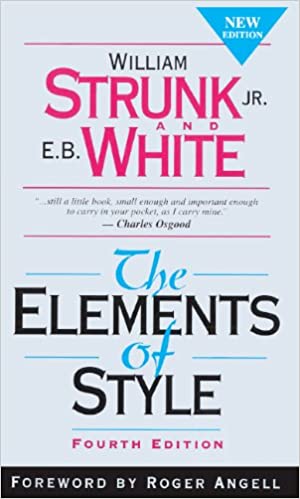Category: Communication
(29 von 100)
Why: I write with no rules.
Goal: learn the basic rules and principles for better writing.
Table of Contents
Action: Put style reminders in your pocket.
3 Key Concepts
- Study the rules, then you can break them with purposes.
- The approach to style is by way of simplicity.
- A writer is a gunner; he must cultivate patience.
Summary
This little book will be my bible for the rest of my 71 blogs journey. It guides you from usage rules, composition principles, forms, misused expressions, and style approaches.
As we write every day, how we write is more habitual than we think. To write better is a work in progress. It demands patience.
In this blog, you will see only partial content. I use this as my mistake reminder. Checking off each mistake I fix. Hopefully, some insights inspire you to adopt them as rules in your writing.
Elementary Rules of Usage
- A colon tells that follows is closely related to the preceding clause.
- The colon has more effect than the comma, less power to separate than the semicolon, and more formality than the dash.
- Word that intervene between subject and verb do not affect the number of the verb: one of … (plural verb)
- Use a singular verb after each, either, everyone, everybody, neither, nobody, someone.
- Gerunds usually require the possessive case.
Elementary Principles of Composition
Structural design underlies every kind of writing.
- The best design is no design, as with a love letter.
- The brevity is a by-product of vigor.
- Put statements in positive form.
- Prefer the specific to the general, the definite to the vague, the concrete to the abstract.
- Omit needless words.
- The position is the principal means of showing their relationship.
- Modifiers should come next to the words they modify.
- Keep to one tense.
- Place the emphatic words at the end or at the beginning: Home is the sailor.
Consciously or unconsciously, the reader is dissatisfied with being told only what is not; the reader wishes to be told what is.
Matters of Form
- Do not draw attention to it by enclosing it in quotation marks.
- Indent for the entire quotation line.
- Do not spell out dates or other serial numbers.
Commonly Misused
Replace vague generality with a definite statement.
Approach to Style
Style has no such separate entity; it is nondetachable, unfilterable. The approach to style is by way of plainness, simplicity, orderliness, sincerity.
- Place yourself in the background.
- Write in a way that comes naturally.
- Work from a suitable design.
- Write with nouns and verbs.
- Revise and rewrite.
- Do not overwrite.
- Do not overstate.
- Avoid the use of qualifiers.
- Do not affect a breezy manner.
- Use orthodox spelling
- Do not explain too much.
- Do not construct awkward adverbs.
- Make sure the reader knows who is speaking.
- Avoid fancy words.
- Do not use dialect unless your ear is good.
- Be clear.
- Do not inject opinion.
- Use figures of speech sparingly.
- Do not take shortcuts at the cost of clarity.
- Avoid foreign languages.
- Prefer the standard to the offbeat.
These are the times that try men’s souls.
Thomas Paine

Goal check: Not achieved. I couldn’t learn rules and principles in one read.
Wasu’s Review
( 5.0 / 5.0 )
Get this book on Amazon here!
Bonus: E. B. White respected William’s teaching.
If you don’t know how to pronounce a word, say it loud!
William Strunk Jr.
If you don’t know how to pronounce a word, say it loud!
Why compound ignorance with inaudibility? Why run and hide?

